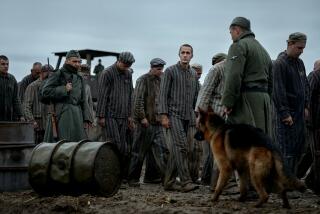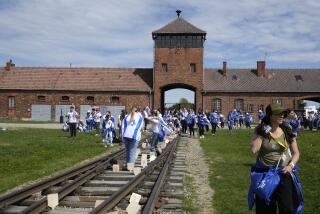Holocaust Survivors Tell Students of Genocide Horrors
By 16, the age of many of her listeners Wednesday, Susan Ziemer-Brender had already contemplated suicide in a Czechoslovakian wartime ghetto, labored as a prisoner in the shadows of the Auschwitz smokestacks and suffered through two days of a Nazi death march.
At the same time in 1945, Rita Lurie and 13 members of her Jewish family lived in hiding in a Polish farmer’s attic, eating only occasional scraps of food and praying for the German occupation to end before they were caught and sent to a death camp.
Both women, now San Fernando Valley residents, survived, although several relatives did not.
On Wednesday, the women recounted tales of the Nazi genocide that blighted their youths for about 300 students at a Burbank Catholic high school as part of this year’s Days of Remembrance, a weeklong commemoration--April 26 to May 3--of the Jewish Holocaust.
For Ziemer-Brender, 63, a Burbank therapist and mother of five who spent two harrowing months in Auschwitz, the memories still ache.
“That place was the kind of nightmare that really is hard to talk about,” she said of the infamous German extermination camp in Poland. “Even at this time--half a century later.”
She explained to her rapt audience about the tattooed number still visible on her arm and the sorting process upon arrival that permitted her to live but sentenced others immediately to the gas chambers.
Near the war’s end, she and fellow inmates were forced to retreat from approaching Russian troops with their fleeing guards, who in desperation began gunning down prisoners unable to keep up.
“No one had just shot us down cold for not walking,” she recalled. “So we decided to escape because we just couldn’t make it.”
She and other prisoners, bedraggled and emaciated, fled the march after two horrific days, hiding from the Nazis until the Allied liberation not long afterward. She immigrated to the United States two years later.
Ziemer-Brender’s story gave students at Providence High School a rare window into a tragedy that has remained mostly confined to the pages of books and the frames of films in their religious studies classes. The assembly, sponsored by the Burbank Human Relations Council, was held before the Days of Remembrance week to give the speakers time to also appear at six other schools.
After the assembly, teen-agers peppered Ziemer-Brender and Lurie with questions.
In the face of such atrocities, “how were you able to get up every morning?” one youth asked.
“Nobody was going to destroy me,” said Lurie, 54, a North Hollywood resident whose mother and brother died of starvation while the family was in hiding. “I will die when God wants me to die.”
Ziemer-Brender added that although she flirted with the idea of suicide during her first days in a ghetto in Czechoslovakia, the will to live grew in strength as time went by and the horrors she faced grew worse.
She issued a gentle challenge at the end when asked if she believed that the Holocaust could be repeated.
“That’s really up to you, isn’t it?” she said as she sat before the teen-agers in the school’s gymnasium. “I’m honored to be here, but the real purpose is that you have an awareness so it doesn’t happen again.”
More to Read
Sign up for Essential California
The most important California stories and recommendations in your inbox every morning.
You may occasionally receive promotional content from the Los Angeles Times.










